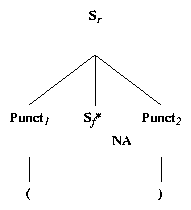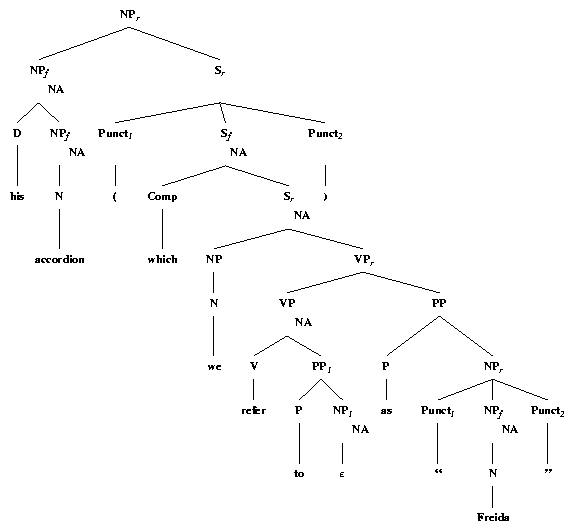

 |
 |
| (a) | (b) |
There is a convention in English that quotes embedded in quotes alternate between single and double; in American English the outermost are double quotes, while in British English they are single. The contains feature is used to control this alternation. The trees anchored by double quotation marks have the feature punct contains dquote = - on the foot node and the feature punct contains dquote = + on the root. All adjunction trees are transparent to the contains feature, so if any tree below the double quote is itself enclosed in double quotes the derivation will fail. Likewise with the trees anchored by single quotes. The quote trees in effect ``toggle'' the contains Xquote feature. Immediate proximity is handled by the punct balanced feature, which allows quotes inside of parentheses, but not vice-versa. In addition, American English typically places/moves periods (and commas) inside of quotation marks when they would logically occur outside, as in example (523). The comma in the first part of the quote is not part of the quote, but rather part of the parenthetical quoting clause. However, by convention it is shifted inside the quote, as is the final period. British English does not do this. We assume here that the input has already been tokenized into the ``British'' format.
The PUsPU can handle quotation marks around multiple sentences, since the sPUs tree allows us to join two sentences with a period, exclamation point or question mark. Currently, however, we cannot handle the style where only an open quote appears at the beginning of a paragraph when the quotation extends over multiple paragraphs. We could allow a lone open quote to select the PUs tree, if this is deemed desirable. Also, the PUsPU is selected by a pair of commas to handle non-peripheral appositive relative clauses, such as in example ((524)). Restrictive and appositive relative clauses are not syntactically differentiated in the XTAG grammar (cf. Chapter 15).
The trees discussed in this section will only allow balanced punctuation marks to adjoin to constituents. We will not get them around non-constituents, as in ((525)).